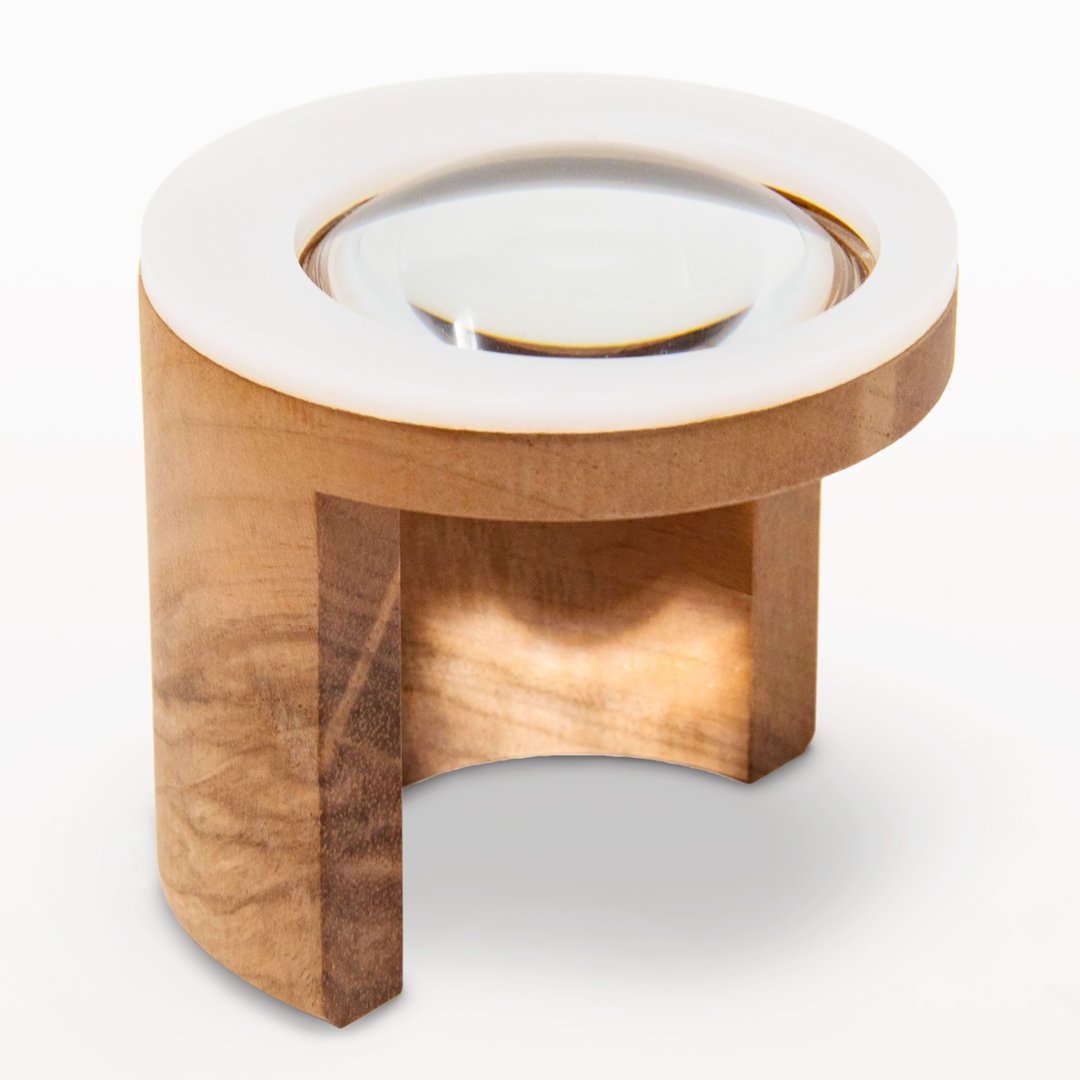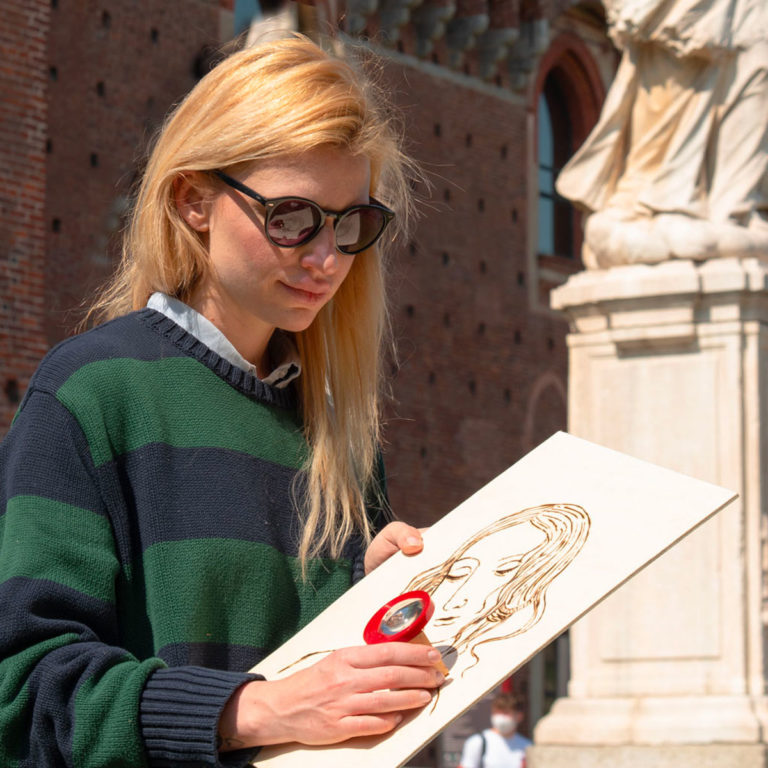FROM PYROGRAPHY LENSES TO SOLAR ENGRAVING
The history of burning glasses as tools to harness the power of the sun goes down the dawn of times. At first, we probably used vases filled with water as rays of sunlight catalyst, directing them to wood or straw. Certainly, this was the beginning of a millenary history, when we controlled sun light in order to burn or carve!
The first evidence in history of burning glasses

The first lens that we know of is the Assyrian Nimrud Lens, a round piece of glass from the 8th century BC found in Iraq. We can’t be sure if it found application as a burning glass. Nonetheless, some ancient Egyptian hieroglyphs of that same period depict the use of similar meniscus lenses. The discovery of these rudimental lenses paved the way for the use of mirrors and glasses for many different applications during the centuries.
Strepsiades:“Have you ever seen this stone in the chemist’s shops, the beautiful one you can see right through, they use to start a fire?“
Socrates: “Do you mean the burning-glass?“
Strepsiades: “I do. What if I took that glass, and when the scribe was writing out the charge, I stood between him and the sun – like this- some distance off, and made his writing melt, just the part about my case?”
Socrates: “By the Graces, that’s a smart idea!”
Aristophanes – “The Clouds”, a dialogue between Socrates and Strepsiades about burning glass – 5th century B.C.
The dialogue above is an excerpt of Aristophanes‘ “The Clouds”, a comedy written in 423 BC in Athens, Greece, for an ancient festival in honour of the god Dionysus. The character of Strepsiades, a farmer persecuted by creditors, is considering to use a lens to erase his debt written on clay tablets. This dialogue marks the first written evidence in history of a burning glasses, as a tool commonly used in daily life.
A defense weapon

Another Greek who probably used burning lenses is Archimedes, who went down in history for his mathematical discoveries and engineering inventions.
A 6th century treatise written by Anthemius of Tralles tells a story about Archimedes and his use of burning glasses. According to the myth, in 212 BC he elaborated an ingenious strategy to defend the city of Syracuse from a naval siege by Romans. He got huge mirrors installed on the walls of the city to incinerate Roman boats approaching the coast. Unfortunately, Greeks are known for their love for wine and the Roman army entered the city while the guards were celebrating the goddess Artemis.
This myth inspired others to find similar solutions against enemies. In 515 AC, Proclus Oneirocrites purportedly used this same strategy to destroy the fleet of Vitalian during the assault of Constantinople. Other scholars disagree on the use of burning glasses in this occasion. They think that a sulphur-based chemical close to Greek fire was the real treat Vitalian army had to face. Nonetheless, the research upon lenses continued to improve.
Setting off the sacred fire
Lighting a fire using the solar power is indeed a spectacular event with a magical and mysterious charm, that has really fascinated mankind during the centuries. It’s no surprise that burning glasses were used during religious ceremonies, such as the Christian Easter celebration. For instance, Saint Boniface (672 – 754 AC) explained to Pope Zachary his use of crystal lens to focus the rays of the sun in order to light up the sacred fire of the Holy Saturday.
Advancing the scientific progress

In more recent times, science took advantage of the lenses’ capacity to concentrate heat in a single point. This led to impressive discoveries during one of the experiments of French scientist Antoine Laurent Lavoisier. In 1774 he used a huge burning glass to discover oxygen. This ended the millenary belief of the 5 elements that compose the world: air, fire, water, earth, and ether. It was the beginning of modern chemistry, and all thanks to these lenses!

Nowadays, burning glasses still find some applications in the energy industry. They can generate a huge amount of energy, without polluting or producing waste. An example, is the solar furnace. This structure concentrates solar energy, usually with directional mirrors, in a single place in order to reach high temperatures. This concentrated energy – usually in an area smaller than a hob – can reach temperatures up to 3.500° C (6.330 degrees Fahrenheit)! The Odeillo solar furnace, located at Font-Romeu-Odeillo-Via in the Pyrénées-Orientales, is one of the biggest and it was built during the 1960’s. It uses 9.600 mirrors reflecting the sunlight into a 40cm target, in the centre of the main tower. The heat reached is the equivalent of 10.000 suns and is used in aerospace and nuclear safety research. Certainly a better use of these lenses than the bellicose ideas of ancient scientists!
An everyday use, for everyday creativity
After more than two millennia from Archimede’s burning mirrors, what is the new frontier of burning glasses?
Fortunately, we stopped using mirrors as weapons- and this is already good news. However, we invented a way to use sun to create art! Febo is the first solar engraver capable to convey the sun energy to draw on natural canvas such as wood, leather and cork. Similarly to a solar furnace, it doesn’t need electricity to work and it’s the first pyrography tool that only needs a glass and the sunlight! This simple yet inventive tool is designed and produced in Italy. It allows creatives around to world to express their artistic visions thanks to the the solar power. Learn how to engrave with the sun, and start creating outdoors!
At the very end of the long history of burning glasses we can finally create instead of destroy, with the use of this little, but powerful, tool!














Thank you so much for this some I knew and some new to me
Hi Son0fbob, we are glad you could learn something new from our blog!